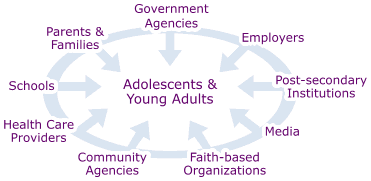 |
National Center for Chronic Disease Prevention and Health Promotion
|
|
|
|
|
|
|
||
|
National Center for Chronic Disease Prevention and Health Promotion |
||||||||
|
|
|
|||||||||||
During the transition from childhood to adulthood, adolescents establish patterns of behavior and make lifestyle choices that affect both their current and future health. Serious health and safety issues such as motor vehicle crashes, violence, substance abuse, and sexual behavior adversely affect adolescents and young adults. They also struggle with behaviors that will affect their risk of developing chronic diseases in adulthood, such as eating nutritiously, engaging in physical activity, and choosing not to use tobacco.
Behaviors of young people are influenced at the individual, peer, family, school, community, and societal levels. Because many societal factors contribute to adolescent health, safety, and well-being, a collaborative effort engaging multiple partners and sectors is necessary. Such joint efforts can also help to promote a more comprehensive approach to addressing adolescent health—one that views adolescents as whole persons, recognizing and drawing upon their assets and not just focusing on their risks.

See Health Topics for information on six critical types of adolescent health behavior that research shows contribute to the leading causes of death and disability among adults and youth—alcohol and drug use, injury and violence (including suicide), tobacco use, nutrition, physical activity, and sexual behaviors.
Other important issues that affect children and adolescents are also addressed, including asthma, childhood overweight, food safety, mental health, skin cancer, and terrorism.
YRBSS
Youth Risk Behavior Surveillance System
monitors six categories of priority health-risk behaviors among youth and young
adults at the national, state, and local levels.
Youth Online: Comprehensive Results
YRBSS includes Youth Online: Comprehensive Results.
Youth Online is an interactive system that allows comparisons of comprehensive results from the Youth Risk Behavior
Survey. Data are available from 1991-2003.
Profiles
School Health Profiles
helps state and local education and health agencies monitor the current status
of their school health programs. State and local agencies conduct the survey
every two years among middle/junior high schools and senior high schools in
their states or districts, respectively.
SHPPS
School Health Policies and Programs Study
is a national survey periodically conducted to assess school health policies and
programs at the state, district, school, and classroom levels.
Improving the Health of Adolescents & Young Adults: A Guide for States and Communities is designed to help guide state and local agencies and organizations through public health processes that address important adolescent health and safety issues.
CDC's Division of Adolescent and School Health (DASH) supports the development and implementation of effective health promotion policies and programs that address priority health risks among youth. See DASH-funded state, territorial, and local agencies and tribal governments and national nongovernmental organizations. These partners are funded to help build or strengthen their capacity to improve child and adolescent health.
National Initiative to Improve Adolescent Health is a public-private partnership that aims to protect and promote adolescent health and well-being by fostering cooperation among different partners, including states, for attaining critical health objectives for adolescents and young adults.
Program Evaluation provides resources for using program evaluation to better document program activities, report achievements, and improve program effectiveness.
Steps to a HealthierUS is an initiative from the U.S. Department of Health and Human Services (HHS) that advances the goal of helping Americans live longer, better, and healthier lives. The Steps Cooperative Agreement Program funds 40 communities nationwide to implement school and other community-based programs that address obesity, diabetes, and asthma, as well as their related risk behaviors: physical inactivity, poor nutrition, and tobacco use.
Addressing Health Disparities. In the United States different racial and ethnic populations, as well as sexual minority populations, suffer disproportionately from preventable diseases and conditions, many of which result from health-related behaviors that are established during childhood and adolescence.
Registries of Effective Programs lists federally-sponsored registries that include programs with evidence of effectiveness in reducing youth risk behaviors.
Healthy Youth Home |
Contact Us
Page last reviewed: October 23, 2008
Division of Adolescent
and School Health
|